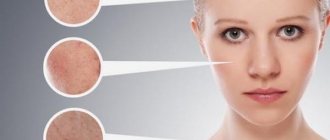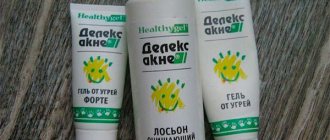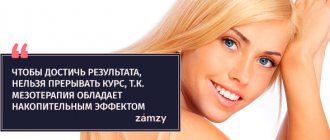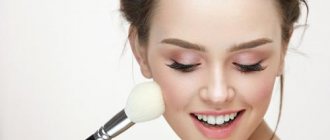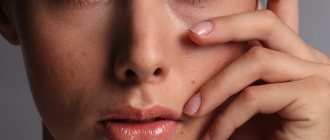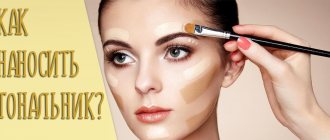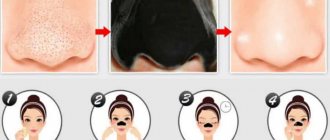01/05/2017 / Classic makeup
Perfect facial skin is what absolutely every woman dreams of. 70% of the world's female population has skin problems, some of which may appear due to age. For example, young girls want to disguise acne that appears due to changes in a young body, and women over 30 years old try to hide wrinkles. There are many ways to improve the skin, various masks and creams, but the results from them will only come after a certain time. If you don’t want to wait to get beautiful skin in a matter of minutes, then a face concealer is exactly what you need. The corrector has a wide range of colors, which are specifically selected for specific problem areas. And now we will tell you how to use face corrector.
Definition of cosmetic facial corrector
Corrector or concealer is a product for masking minor skin defects and for treating them. Its fundamental difference from the usual foundation or concealer is the local application: the corrector is applied pointwise, only to the problem area. Then use regular foundation or powder - the latter is preferable.
The product is available in a very unexpected color palette. If the shades of the same cream are as close as possible to the natural skin color, then the corrector can be green, red and even lilac. This is due to the fact that you can hide a defect much more effectively if you use a complementary color.
Professional proofreader
The product is applied first, foundation second.
Corrector is a therapeutic agent. In most cases, the composition includes salicylic acid, which successfully dries out acne and suppresses pathogenic microflora. That is, the product not only hides defects, but also helps get rid of them.
Common mistakes when working with a color palette
The task of a makeup artist is to create a perfect image, transform a woman’s face, hide imperfections and add new accents, and select the most suitable range for tone and contouring. Makeup should look natural and flawless. But often beginners make mistakes that are easy to spot by eye.
Let's introduce the most common mistakes to avoid when working with a color palette:
- If there are no obvious defects on the skin, you can limit yourself to foundation. Concealers are used for intensive camouflage.
- Bright shades in contouring are used in evening or themed makeup for photo shoots.
- Without shading, the lines look drawn separately. It looks stupid and unnatural.
- A thick layer of concealer loses its camouflage functions and will look like a separate greasy stain. Only a thin application hides imperfections and makes them as invisible as possible.
- The corrector must be applied with a special brush using tapping movements. You cannot achieve the desired effect with your fingers.
In what cases is it used?
Initially, the corrector was produced in the form of a hard pencil and had a narrower specialization. Then other types of composition appeared, and the scope of its application expanded.
A corrector is required in the following cases.
- Age spots - freckles, birthmarks. The latter may be small in size, but, alas, they are dark in color, and, unlike moles, they have an irregular shape. Regular foundation is not very suitable for camouflage, since its structure is too light and transparent. The corrective composition is much denser and thicker and does a good job of hiding marks.
- The scars are small, of course, and not too deep. In this case, it is important not only to disguise the defect with the desired color, but also to even out the surface of the skin. The dense consistency of the concealer is ideal for this.
- Acne is a variety of pink or red rashes, and even more so, it is impossible to disguise inflamed ones with foundation. The corrector solves the problem differently: to hide the redness, use a product of a complementary color. This mixture of shades neutralizes each other, as a result, the rash will no longer be noticeable under regular foundation.
In addition, the corrector also provides acne treatment. If you have acne, you should not use conventional cosmetics, as these compounds clog the pores, which promotes inflammation and the rapid proliferation of bacteria. The corrector contains salicylic acid. This substance suppresses the activity of the sebaceous glands, dries out the skin, thereby eliminating a favorable environment for the growth of bacteria. Accordingly, inflammation also gradually decreases.
- Spider veins - red "stars" - are also difficult to disguise. But if you hide the “mesh” under a green corrector, the skin in the area acquires a completely natural color.
- Dark circles under the eyes are more of a concern for concealer than for corrector. However, with pronounced bruises, a regular cream will not work. Blueness is masked with a composition of the corresponding complementary shade. Preference is given to the liquid form, since the skin under the eyes is too delicate.
The corrector dries out the skin, so it should not be used frequently on areas that are already depleted of sebaceous glands.
- Scratches – thanks to salicylic acid, the corrector can be applied even to fresh scratches. True, the skin will pinch for some time.
What concealer is not suitable for is concealing deep wrinkles. A dense structure will not only not hide the defect, but will also emphasize it.
What is concealer and what is it for?
Before figuring out how to apply concealer correctly, read the basic information about the product in question. The concealer is designed for spot masking of minor facial defects.
Its texture is an opaque, dense beige product. Concealer for the eyes and other areas of the face is much more effective compared to regular foundation. It allows you to hide even age spots and pimples that classic foundations cannot cope with.
Yellow equalizer can also, like green, mask minor redness, pimples and blackheads. Remember, however, that you will not achieve as good a result as applying a green tint. This is the ideal feminine equalizer, which is characterized by thin and pale facial skin, from which you can see veins and small bruises, for example, after cosmetic surgery. A pale complexion will also add radiance and a healthy appearance. Concealing the shadows under your eyes can also be helpful, but be careful—not all of us will provide adequate coverage.
Important! Facial concealer should not be considered a complete foundation. At the same time, even a thick layer of the highest quality foundation will not allow you to achieve a perfectly even color. To achieve maximum results, they must be used comprehensively.
Mechanism of action
The action of the corrector is based on its main features:
- structure - of all foundations, the corrector has the thickest, dense consistency, even solid, if we talk about a pencil. Thick texture and allows you to mask the darkest and brightest spots;
- durability - conventional oil- or water-based products begin to gradually erode after application. The most thorough washing will not stop the work of the sebaceous glands, so soon the sebum dilutes the structure of the foundation and the makeup “floats”. The corrector includes salicylic acid, which significantly slows down the effect of fat and does not allow the disguise to disappear so quickly;
- color - if a regular foundation is chosen as close as possible to the skin color, then the shade of the corrector is chosen according to a different principle. So-called complementary colors - those located on opposite sides of the color palette, neutralize each other. A spot application of green corrector on inflamed pimples will completely hide the redness.
Applying a corrector
The concealer does not even out the complexion and does not promise to make the skin matte and radiant. Its task is to disguise pronounced defects. This explains its local application.
How to properly apply concealer on your face: a detailed guide
It's not difficult to figure out how to use concealer. The sequence is as follows:
- the skin is cleansed and moisturized;
- Problem areas are found and masked with concealer.
In this case, you should try not to touch healthy skin. For application it is best to use a special brush. You can blend with a brush or your fingertips.
After all problem areas are hidden, foundation is applied.
Now you know what concealer is, what it is used for and how to apply it. There will be no more problems with creating professional makeup at home. Just follow the recommendations received and everything will definitely work out. Good luck!
Types of concealers
In addition to the traditional form - pencil, correctors are available in a variety of forms. For the right choice, both consistency and color palette are important.
By composition: dry pencil, cream base, liquid and the difference between them
The convenience and effectiveness of the corrector forced manufacturers to develop several forms, essentially combining the qualities of a corrective and foundation product. This is how various implementation options appeared.
- Pencil – has a dry texture and the highest possible density.
Thanks to the inclusion of salicylic acid, it has very high durability and is ideal for girls with oily and normal skin. If you have dry skin, use it carefully. Corrector in the form of a pencil
The dense structure provided the product with other uses. The pencil can be used as a primer: the entire surface of the lips is shaded with the product and lipstick is applied on top. This guarantees complete preservation of makeup even in the hottest heat. A white pencil is also used when you want to visually increase the volume of your lips - outline them, or make your eyes bigger.
- Stick is a retractable pencil in a plastic case. Its structure is more delicate, but enough to hide an inopportunely appeared pimple. Sticks most often have the color palette of foundation. It can also be used to disguise dark circles under the eyes, but not too hard.
- Liquid corrector – has the most delicate creamy texture. It can be applied either spot-on or over large areas of the skin - under the eyes, on the forehead, on the cheeks. The product does not contain salicylic acid, so it does not dry out the skin, but it does not treat acne. Liquid concealer is more suitable for cases when you need to change your complexion.
Liquid face corrector
The product is available in the form of a bottle with an applicator or brush: it is much more convenient to apply. Some formulations contain various additives, both for skin health - moisturizing components, and decorative ones. For example, liquid reflective corrector includes tiny particles of mother-of-pearl. With its help, it is possible to hide swelling and minor edema.
- Cream corrector - the most popular in the form of a palette, including from 4 to 15 colors. Designed for application to large areas of the face and is most suitable for those with dry to normal skin. Its structure is too dense for oily skin. The covering power of the cream is sufficient to hide age spots, freckles, and shadows under the eyes. However, this is not enough to disguise spider veins and inflamed acne.
Cream corrector
The creamy corrector is applied with a brush or sponge. A big plus of this solution: the ability to correct not just the color, but also the relief of the face, that is, to emphasize the cheekbones, make the bridge of the nose visually higher, lips larger, and so on.
- Dry concealer is essentially colored powder. Not the most popular form, as it is more difficult to apply. However, those with oily skin should prefer it, as the powder reduces shine and makes the face matte.
Dry corrector
Color palette
The color palette is a variety of shades with the exception of black and white. Colors are arranged in a certain sequence, divided into warm and cold. The palette is most often presented in the form of a color wheel, since this form of combination of shades turns out to be the most understandable.
Shades located next to each other - orange and scarlet, for example, are close, and those placed on the opposite side of the circle are complementary. When complementary colors are mixed, a pure gray shade appears because the colors have completely neutralized each other.
This effect formed the basis of the color palette of the corrector. Its shades - red, green, purple, at first glance seem unusually bright and cause distrust, but the very first practical experience convinces of the validity of the above.
- Green – cold mint. Absorbs red color. Green pencil is used to disguise pimples, especially inflamed ones. They are quite suitable for hiding spider veins and redness in the nose area. The corrector does not give the rash a green color, but it properly shades the inflamed area. When applied on top of a regular nude foundation, the defect is invisible.
- Yellow is the opposite of blue and violet, and therefore is used to disguise blue circles under the eyes, protruding wreaths, hematomas - small ones, of course, and even tattoo marks. For the first case, a liquid corrector is preferable; for the rest, a pencil is suitable.
Yellow is used to hide small scars and acne marks: it visually evens out small defects.
- Orange is the opposite of blue and green. Also used to hide blue circles under the eyes. Additionally, for cool and pale complexions, orange can be used over large areas to give the skin a warmer, more vibrant complexion.
When choosing a product, be sure to observe a combination of cold and warm tones. So, with peach skin, orange corrector cannot be used to disguise shadows under the eyes. But for a pink, cool complexion it is better suited than yellow.
- Lilac – pale lilac or lavender. Resists yellow and is used to disguise yellowness. This applies to both individual areas - large yellow pigment spots, freckles, yellowing of the skin, and the entire face. Lilac liquid corrector is used as a basis for whitening skin with a clear yellow tint - Asian.
Purple or blue corrector is used for severe sunburn. However, this option is not suitable for those with dark skin, since lilac is a cool tones.
- Blue – suitable for hiding brown circles, age spots, freckles and redness caused by excessive sun exposure. Sometimes a dry blue corrector is used to shade the eyelids: with generally pale, cool-toned skin, it gives them a porcelain tint.
- Pink – used locally to hide brown circles around the eyes or lighten too dark eyelids. Pink gives freshness to gray, sallow skin, but moderation must be used here, otherwise the face turns into a doll mask.
- White - quite rare. This color is not used on its own, but is used to dilute too bright and thick colors in the palette.
- Bodily - with its help you can disguise less pronounced defects, for example, non-inflamed acne. More often, nude correctors of different colors are used to create complex makeup. Using different shades they visually change the proportions and contours of the face.
Corrector color palette
A concealer palette is a universal and convenient thing.
Here it is in your hands, one of the components of female happiness, a concealer palette, a powerful assistant, an ally in achieving the ideal of beauty. This is a unique set of decorative cosmetics with a paste-like texture and moderate thickness. There are tonal products in yellow, orange, blue, green, violet, and other colors.
After a while, fill everything in but gently; if you use too much powder, the skin will be darker. Equalizer instead of eye shadow. Is there a way to effectively hide sleepless nights? Yes, the basic rule: whereas cosmetics are on the face and as much as an equalizer, but, of course, applied correctly.
You need to focus on two things: on the skin, which will be good, on the lighting and on the eyes, for makeup you will need an equalizer. Choose one that is brighter than the skin and draw three thick lines: the inner corner of the eye, the upper eyelid just below the lash line and under the eyebrows on the outside. Gently roll out the edges of the equalizer, it will illuminate your eyes well and make them look refreshed. Lastly, apply eyelashes and always use an equalizer to disguise the shadows under the eyes. Skip using eye shadow completely on this day.
How does it work? What should you know to choose the right shade of concealer?
Once upon a time at school, during art lessons, the teacher revealed the little secrets and tricks of color: if you put green on top of yellow, you get blue. The work of concealer is based on the same principle.
Many women, even when doing very careful evening makeup, forget about the most central part of the face, the nose. We're not even talking about visually correcting its shape with different shades of equalizer and bronzer, but covering the reddened areas around the nose and the surface of its petals with often visible fine lines and cracks.
So if you want your makeup to look complete and your face to look good, never forget your nose. Because his surroundings are the area belonging to the so-called. If you don't have one, use a different, less liquid equalizer that finally fills up. Even the best selected equalizer will fail if, instead of adhering perfectly to the skin, it gets into its folds and fine wrinkles. Luckily, there are several ways to fix this. First of all, make sure your skin is well hydrated and hydrated before applying makeup.
Each skin defect is colored in its own color: moles are brown, pimples are reddish, freckles are red, pigmentation is yellowish... And to hide these defects, you simply need to use another color, the opposite one. It can be easily identified by the color wheel representing the couples. Colors located opposite each other make up opposite pairs. These colors neutralize each other and help hide skin imperfections.
If it is dehydrated, it can cause the equalizer to "weigh" and roll. A good way to do this is to mix your makeup with a light face cream, liquid and equalizer and apply a face mask instead of three separate layers. In the case of the eye area, it is recommended to dry the surface of the skin, carefully apply a sanitary towel to the surface and collect excess moisture. This will prevent the equalizer from settling in the thin skin around the eyes. If, despite the tendency to do so, remember to carefully discard the excess with a small piece of dry wipes throughout the day.
Using this hint, it is easy to find the right concealer; the main thing is to remember that colored concealers are selected taking into account the color of the skin defect that needs to be disguised. That is, if you want to hide freckles, you take a purple concealer, and red pimples are neutralized with green.
The correlations and colors of concealer, lighters, foundations and powders are so difficult to decide. But when you see blue, green, purple or yellow camouflage products on the shelves, there's a definite reason for developing them. How to use them to eliminate beauty flaws and even less noticeable ones? The task is to hide imperfections and highlight the advantages of beauty. On the other hand, the effect of our morning efforts is often counterproductive. Instead of covering the pimple, we highlight it with a balance that is always either too dark or too light, and each use of a corrective product ends up roughly the same: instead of the rest of the face, our interlocutor concentrates on exactly what we were trying to hide.
But there is one more thing to consider: each person’s skin is unique. Some have dark skin, others have yellowish skin, and there are people with very fair skin. The reason lies in the fact that human skin contains four types of pigments, which affect its tone. Carotene gives yellowness to the skin, it quickly becomes tanned due to melanin, veins have a bluish tint due to the presence of deoxyhemoglobin, and due to oxyhemoglobin, the blood is red. Using colored concealers, you can give your facial skin a uniform tone. Therefore, there is a need to purchase concealers of different shades. A set containing several shades of the same color helps to make the choice easier and solve the problem efficiently.
We'll take care of another time. Makeup colors have an additional effect on skin lesions. neutralize them. Green - corrects yellowish cells - eliminates redness in large areas of the skin. Purple - illuminates pink skin. It also illuminates and gently removes grey, tired discolorations in darker skins.
It's definitely a good idea to choose the right background and equalizer. In case of discoloration, only camouflage is used. No base or equalizer, because instead of distracting attention from the spot, it will still attract it. Of course, a person who has discoloration should not afford a light foundation, only on a thicker product. This will prevent the skin from looking too over-dyed. Dark spots attract light and appear even more pronounced in a dull color. Therefore, after applying the undercoat, we achieve a lightening product.
How to use foundation correctly
There are many ways to apply concealer. The choice is determined by the purpose and scale of the task: whether to quickly remove a suddenly popping pimple out of sight, or change the proportions of the face.
- Age spots, pimples, and freckles are actually the easiest to disguise. If the color is light enough, you can get by with a nude concealer; if the pimple is inflamed, use a green one. A dot is applied with a pencil or stick, its borders are shaded, and the skin is powdered.
- When masking the vascular network, a softer green corrector is used - liquid or creamy. On the nose, however, the mesh can be masked with a pencil. Then apply regular foundation on top.
- To hide circles under the eyes - blue, brown, choose a product of the appropriate shade, but preferably with a liquid consistency. The pencil is too thick and will weigh down the eyelid skin. If there is also swelling under the eyes, the pencil is excluded.
- Swelling is somewhat more difficult to disguise. To do this, apply the required corrector - pink or blue - to the area under the eyes, then apply a base tone to match the skin tone, and lastly, apply a flesh-colored corrector 1 tone whiter to the area below the swelling, as if brightening it.
Correctors for yellow and green shades are always applied under the main foundation. The rest can be used on top of the base.
A palette with correctors of different shades will help you radically change your face. The effect is achieved through an appropriate combination of shades. A lighter tone makes the area visually larger, and a darker tone makes it appear smaller and smaller. Accordingly, areas that need to be highlighted are treated with a light corrector, and those that need to be hidden are treated with a dark one.
The standard scheme for creating classic proportions looks like this.
- Obvious defects such as acne, blemishes, and circles under the eyes are masked.
- It is preferable to darken areas with a dry corrector. Color – 2 shades darker than the main one. It is usually applied to the contours of the face to make them more defined. Also, dark tones are required to soften a rectangular face - applied along the contour of the jaw, to reduce a disproportionately wide or high forehead, to reduce the upturned tip of the nose.
- They highlight areas in such a way as to make the face prominent and expressive. Traditionally, these are the highest areas of the cheekbones, the bridge of the nose to make it higher, the area above the upper lip and on the chin - this combination makes the lips more voluminous.
The same light corrector is used to correct imperfections. So, with a flat face, use a light tone to highlight the area under the cheekbones to make them more expressive. When highlighting the nasolabial folds, they seem not so deep. A light corrector on the entire bridge of the nose gives it subtlety and makes it smoother and longer.
- Be sure to highlight areas under the eyes and in the corners. The first makes the eyes larger, the second disguises wrinkles.
- The boundaries between the areas are shaded and a light foundation is applied or simply powdered. After this, you can begin applying the actual decorative makeup.
Procedure for applying the corrector
The applied products must be very carefully shaded until the borders completely disappear. Otherwise, the face will look extremely unnatural. The makeup of the models is not an indicator in this case, since when photographing, high sharpness of features is needed. In natural light it looks weird and rough.
Using correctors in contouring
The corrector is used not only to disguise defects. This product is an excellent tool for adding the desired volume, shades, beautiful relief and texture. Here it is important to create the correct color scheme, taking into account the structural features and shape of the face. To solve these problems, makeup artists use a palette of at least four shades, which includes light and dark colors.
What problems do dark correctors solve:
- To form the desired contour, dark bronze lines are applied. The shade is selected two shades darker than the base skin tone.
- With a dark corrector you can visually narrow your nose, chin, cheekbones, and forehead line. Carefully blend the borders, make a smooth transition to the light central zone.
- Be careful with too dark shades - they suit dark skin, but will contrast unnaturally on light skin.
- Why use light corrector in make-up:
- To elongate the upper part of the face, highlight the central area of the forehead.
- To make a narrow face narrower, a light corrector is applied with horizontal strokes to the cheekbones.
- Highlighting the brow line helps visually raise your eyebrows and make your eyes more expressive.
- You can lengthen your nose a little and remove its plumpness by drawing a vertical line in the center.
It is important for novice makeup artists to remember the basic principles of working with dark and light correctors: the light one emphasizes the desired areas, the dark one hides imperfections and narrows the volume.
Good models, brands and manufacturers of professional cosmetics
The choice of correctors, concealers and foundations is huge, but some brands are among the most popular.
- MAC – color palette with 15 shades. The structure is light, does not weigh down, does not create a film. Excellent for dry and normal skin. 15 colors allow you to create truly high-end makeup.
- High Precision Retouch, Giorgio Armani is a liquid corrector with a very thin applicator that allows you to treat the smallest wrinkles. In addition, the product includes reflective particles, which gives the skin freshness and radiance.
- New York Affinitone from Maybelline – corrector stick. In addition to a convenient form of use and a good masking effect, it creates a matte shine, which is very useful for oily skin.
- Professional Makeup from NYX is another color palette option. The structure is creamy, quite dense, suitable for masking defects and for evening out color over large areas.
- Alliance Perfect L'oreal - liquid skin color correctors. More often used to create complex makeup with changes in facial proportions. The liquid form can disguise bruises under the eyes and minor inflammations, but is not suitable for hiding vascular networks and acne.
- Essense is a palette of 5 essential colors, from blue to yellow. The texture is creamy and soft, but its masking effect is quite sufficient to hide acne and dark circles under the eyes.
When choosing a product, you need to take into account not only the availability of shades and suitable shape, but also your skin type. For dry skin, oil-based products are preferable; for normal and oily skin, it is better to use water-based products.
The most common models
The corrector pen is now one of the most common office supplies. All well-known companies producing such products produce many models. There are several of the most common ones that are popular due to their high quality, ease of use and low price.
- The best correction pen is Erich Krause. Many users trust this company. Reviews note that this corrector has virtually no drawbacks. It is odorless, beautifully shaped, and easy to use. The metal tip does not scratch the paper and allows you to apply correction fluid precisely. This correction pen is also called arctic white because of its snow-white color.
- Correctors from BRAUBERG are also popular. They are distinguished by a stylish design, a comfortable tip and a soft body that allows you to easily squeeze out the correction fluid. And the metal ball inside prevents it from freezing.
- Many users choose inexpensive correctors. These include products from the InFormat company. Despite their low cost, they are of high quality, odorless, and the liquid dries quickly.
You can choose any corrector pen. If you know how to use them, then no mistakes in the text will be scary. They can be easily covered up with a high-quality corrector.
How to choose a corrector for problem skin
It is recommended to select a corrector taking into account simple rules:
- the product must have medicinal properties, so it is better to purchase it at the pharmacy,
- high quality cosmetics from trusted manufacturers cannot be cheap,
- the corrector should not contain fats and heavy ingredients that penetrate the pores and pollute them,
- Before purchasing, you should determine your skin type and problems in order to purchase an effective product.
It is better to buy concealers on the recommendation of specialists.
Useful tips
Face makeup using correctors
And finally, some useful tips on how to use face corrector:
- Before applying the concealer, clean and moisturize the skin. You can use a primer to create the base.
- To disguise crow's feet on your eyelids, you can mix it with anti-wrinkle gel.
- After applying the colored type, you need to wait a couple of minutes for it to settle.
- Foundation must be applied on top.
- To apply, use an applicator, brush or sponge. This is much more convenient than using your fingers. It's also more hygienic.
- If the problem is very visible, then you can apply it in layers - 1 layer, blend and wait until it is absorbed, then 2 layers.
- For girls whose skin dries and peels, products with a liquid cream consistency are suitable.
- For oily types, dry and denser textures will help more.
- To add freshness to tired skin, choose a product that is a shade lighter than your own. This will add shine.
The beauty industry is developing very rapidly; in stores you can get lost in the abundance of products. A corrector is perfect for eliminating blemishes. It masks blemishes such as acne, other rashes, capillary mesh, post-acne, scars, dark circles under the eyes.
In addition, many manufacturers offer broad-spectrum products: they are used as a highlighter and primer. By choosing the right color, you can even out the tone. But you need to learn how to apply it correctly, otherwise there will be no effect.
